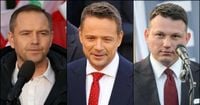As Poland gears up for its presidential elections, the political landscape is becoming increasingly competitive. The first round of voting is set for May 18, 2025, and recent polls indicate that a second round will likely be necessary, featuring leading candidates Rafał Trzaskowski and Karol Nawrocki.
According to a survey conducted by Opinia24 for "Newsweek," Trzaskowski, the candidate from the Civic Coalition (KO), leads with 30 percent of the vote. However, this figure marks one of the lowest results for him in this campaign, raising concerns about his support. Meanwhile, Nawrocki, backed by the ruling Law and Justice party (PiS), follows closely with 25 percent, indicating a tight race.
In the context of the Lublin region, predictions suggest that Nawrocki will dominate with 37.8 percent support, while Trzaskowski is projected to secure only 21.7 percent. This regional disparity highlights the ongoing strength of PiS in areas traditionally aligned with conservative values. Political sociologist Marcin Palade, who prepared the election forecast for "Polska Press," notes that national turnout is expected to be around 63.5 percent, with Lublin's turnout slightly lower at 61 percent.
Historically, the Lublin region has been a bastion for PiS candidates. In 2005, Lech Kaczyński achieved over 70 percent of the votes here. This trend has persisted, largely due to the region's high levels of religiosity and a demographic profile that skews older, favoring the conservative party's message.
Dr. Wojciech Maguś, a political scientist from UMCS, explains that PiS has successfully positioned itself as a defender of traditional values, resonating with the local electorate. "The strong party structures in the region also contribute to their ongoing success," he adds.
In Lublin, the results of past elections illustrate a gradual shift in voter preferences. While Kaczyński received 56 percent in 2005, his successor Jarosław Kaczyński garnered just over 50 percent in 2010. Andrzej Duda's performance also varied, winning 55.5 percent in 2015 and nearly 49 percent in 2020. These fluctuations suggest a potential opportunity for anti-PiS candidates like Trzaskowski in the second round, especially if voter mobilization efforts are effective.
In addition to the frontrunners, the latest polls show Sławomir Mentzen of the Confederation party in third place with 13 percent support in the nationwide survey. However, he appears unlikely to advance to the second round. Following Mentzen, the polls reveal a tight race among several candidates: Szymon Hołownia at 7 percent, Magdalena Biejat at 6 percent, Adrian Zandberg at 5 percent, and Grzegorz Braun at 4 percent. Joanna Senyszyn is the only leftist candidate to surpass 1 percent, indicating ongoing challenges for the left in this region.
Palade's forecast indicates that undecided voters make up about 5 percent of the electorate, which could be critical in the final outcome. He warns that predicting turnout so close to the election carries significant uncertainty, as recent events—particularly the housing scandal involving Nawrocki—could sway public opinion. However, Dr. Maguś believes Nawrocki's established position will likely buffer him against any potential fallout from this controversy.
In terms of regional dynamics, the Lublin area has consistently supported conservative candidates, a trend that has deep roots in the region's socio-cultural fabric. Factors such as high religious observance and a significant elderly population contribute to this consistent support for PiS. Dr. Maguś elaborates, "The demographic structure and the party's alignment with traditional values resonate strongly with the local populace."
As the election date approaches, the political atmosphere is charged with anticipation. The candidates are preparing for a pivotal debate scheduled for May 12, 2025, which will be broadcasted across major networks, including Telewizja Polska, TVN24, and Polsat News. This debate will provide an opportunity for candidates to articulate their visions and potentially sway undecided voters.
In summary, the upcoming presidential elections in Poland are shaping up to be a closely contested affair, particularly between Trzaskowski and Nawrocki. With varying levels of support across different regions and a significant portion of the electorate still undecided, the outcome remains uncertain. As political analysts continue to monitor shifting voter sentiments, the implications of these elections could resonate far beyond the immediate political landscape.
As the first round of voting approaches, all eyes will be on the candidates as they make their final appeals to the electorate. The results will not only determine the next president but also reflect the evolving political identity of Poland.






